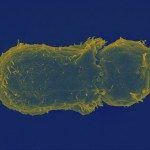Link to Pubmed [PMID] – 9834088
J. Immunol. 1998 Dec;161(11):6054-8
Staphylococcus enterotoxin superantigens are potent T cell activators. To gain new insights into the mechanism of T cell activation induced by these superantigens, we investigated the recruitment of signaling molecules in this process. Here, we show that enterotoxin superantigen activation can be transmitted to TCR-CD3 complexes that did not interact with their ligand. Indeed, by studying cells expressing two distinct TCRs, we found that enterotoxin superantigens induced tyrosine phosphorylation of TCRzeta subunits, the recruitment and tyrosine phosphorylation of the protein tyrosine kinase ZAP-70, and an increase in protein tyrosine kinase activity of both directly stimulated and unstimulated TCR-CD3 complexes. As the involvement of unstimulated TCR-CD3 complexes in signal transduction would increase the number of signaling molecules and, therefore, the efficiency of T cell activation, these data provide a novel explanation for the ability of enterotoxin superantigens to potently activate T lymphocytes.

